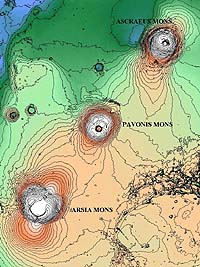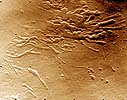 Active Volcanism On Mars
Active Volcanism On Mars

Figure 1. The Tharsis Montes: Arsia, Pavonis and Ascraeus Mons. Contour interval: 400 m. The map, based on MOLA data, was prepared by Adrian Lark.
Abstract: New remarkable MOC images captured over a deeply incised valley system on the northeast Pavonis Mons flank show how erosion has nearly destroyed the pattern of young impact craters. Comparable age for an undisturbed impact crater pattern at Arisa Mons is 40-100 million years (Hartmann et al., 1999). After this erosion event a few scattered impact craters have formed. It is concluded that a major fluvial erosive event took place within valley floor on the northeast Pavonis Mons flank. The timing of this event is clearly well within 10 million years. This suggests that the erosive process responsible for the valley erosion can be regarded as a presently active process. The process of erosion is here regarded as being the outburst of melt-water, commonly referred to as jokulhlaups in Iceland. From volcano-tectonic considerations the erosional valley coincides with the locus of maximum volcanism, yet the Tharsis Montes valley systems are paradoxically devoid of lava surfaces.
This is compatible with subglacial volcanism having caused jokulhlaups that generated the erosional valley systems. From timing considerations the volcanogenic jokulhlaups can be regarded as a presently active process. The valley systems on the northeast and southwest flanks of the three Tharsis Montes volcanoes probably have a second role of being pathways for melt-water released from the caldera of each of these volcanoes. |
Reykjavik - June 5, 2001
>

|
 |
|

 Reykjavik - June 5, 2001
Reykjavik - June 5, 2001